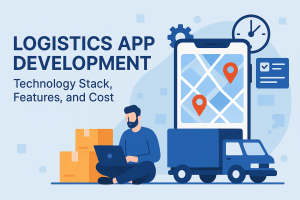React Native has emerged as a popular framework for developers aiming to build robust cross‑platform mobile applications using JavaScript. In this comprehensive guide, we will explore everything you need to know to build a mobile app with React Native, from setting up your development environment to understanding best practices for architecture, styling, and deployment. Whether you are a beginner or an experienced developer looking to expand your skills, this guide will help you craft high‑quality apps that meet modern standards.
We’ll explore the essential steps, common pitfalls and we’ll also discuss key tools and strategies to optimize your development process. Let’s dive in and learn how to build a mobile app with React Native while integrating proven mobile app development strategies and avoiding common mistakes.
Introduction
The global surge in mobile app usage has driven businesses and developers alike to seek effective ways to build applications that run seamlessly on both iOS and Android devices. Build a Mobile App with React Native is a task that many developers aspire to master due to its efficiency and flexibility. React Native enables you to develop high‑performance mobile apps while maintaining a single codebase, a feature that saves time, resources, and ensures design consistency across platforms.
Let’s go through each step of building a mobile app using React Native, ensuring you get practical tips along the way. With the right approach, you can leverage React Native to create stunning apps that not only function well but also offer an outstanding user experience.
Why Choose React Native for Mobile App Development
React Native has gained immense popularity due to its numerous advantages that cater to modern mobile app development needs. Here are some key benefits:
Cross-Platform Capability
With React Native, you don’t need to write separate code for iOS and Android. This cross‑platform approach means you maintain one codebase, dramatically reducing development time and cost.
JavaScript at Its Core
As React Native is built on JavaScript—a language widely known by many developers—it offers an accessible entry point, especially for web developers transitioning to mobile development. This enables you to reuse familiar concepts and libraries.
Strong Community and Ecosystem
React Native boasts a large community, extensive libraries, and continuous updates, making it easier to find solutions and support. This active environment helps with troubleshooting, new feature development, and overall learning.
Performance Optimization
Thanks to its native rendering, React Native delivers near‑native performance for a wide range of mobile applications, ensuring a smooth user experience even in intensive scenarios.
These benefits make React Native an ideal solution for startups and businesses alike. If you’re considering developing your mobile application with external support, you might explore partnering with an experienced Offshore Mobile App Development Company to leverage specialized expertise at competitive costs.
Prerequisites for Building a Mobile App with React Native
Before you start coding, it’s essential to get your development environment and foundational knowledge in place.
Programming Skills
- JavaScript/ES6: A solid grasp of JavaScript, particularly ES6 features, is necessary.
- React Fundamentals: Understanding components, state, props, and the component lifecycle is crucial.
Tools and Software
- Node.js and npm: Install Node.js, which comes with npm (Node Package Manager), to manage packages and dependencies.
- Code Editor: Use editors such as Visual Studio Code or Atom to write code efficiently.
- Emulators/Simulators: Setting up Android Studio or Xcode simulators for testing your app during development is key.
- Command Line Tools: Familiarity with command line operations will streamline your workflow.
Concepts
- APIs and Data Fetching: Learn how to integrate third-party APIs as many apps rely on dynamic data.
- Mobile UX/UI Principles: Understanding basic mobile design concepts will help you create an app that users find intuitive and enjoyable.
For an in‑depth exploration of mobile app development basics, check out mobile app development: a guide for beginners.
Setting Up Your Development Environment
Getting your environment configured properly is a crucial first step in building an app with React Native.
Installing Node.js and npm
Download and install Node.js from the official website. This installation will include npm, which is essential for managing packages.
Setting Up React Native CLI
While Expo is a good choice for beginners, using React Native CLI gives you more control over native components. Install the CLI via npm:
java
CopyEdit
npm install -g react-native-cli
Installing Android Studio and/or Xcode
For Android development, install Android Studio. Make sure to configure your device’s Virtual Device Manager. For iOS, install Xcode if you’re on macOS.
Creating a New Project
Initialize a new project using the CLI:
csharp
CopyEdit
react-native init MyReactNativeApp
This command creates a new React Native project with a default structure ready for you to start coding.
Creating Your First React Native App
Once your environment is set up, you can start building your app. The basic project structure includes folders for components, screens, assets, and more.
Understanding the Project Structure
- App.js: The entry point of your application.
- Components Folder: Contains reusable UI components.
- Screens Folder: Houses different screens or views of your app.
- Assets Folder: Holds images, icons, and other static files.
Building a Simple Home Screen
Start by editing App.js to render a simple home screen with a welcoming message. For example:
javascript
CopyEdit
import React from ‘react’;
import { View, Text, StyleSheet } from ‘react-native’;
const App = () => {
return (
<View style={styles.container}>
<Text style={styles.welcome}>Welcome to My React Native App!</Text>
</View>
);
};
const styles = StyleSheet.create({
container: {
flex: 1,
justifyContent: ‘center’,
alignItems: ‘center’,
backgroundColor: ‘#F5FCFF’,
},
welcome: {
fontSize: 20,
textAlign: ‘center’,
margin: 10,
},
});
export default App;
This simple example introduces you to basic components and styling.
Understanding React Native Components and Styling
Components are the building blocks of a React Native app. They let you encapsulate UI elements and functionalities into reusable pieces of code.
Functional vs. Class Components
With the advent of hooks, functional components have become more popular due to their simplicity and ease of use. However, class components are still prevalent in many legacy projects.
Styling in React Native
Styling is managed through JavaScript objects using the StyleSheet API. Unlike CSS in web development, React Native styles are applied directly to components as objects. For example:
javascript
CopyEdit
const styles = StyleSheet.create({
header: {
fontSize: 24,
fontWeight: ‘bold’,
margin: 10,
},
});
The styling approach ensures that styles are predictable and centralized in your project.
Implementing Navigation in React Native
Navigation is key to providing a smooth user experience. React Native offers several navigation solutions, including React Navigation, which is highly regarded in the community.
Setting Up React Navigation
Install React Navigation and its dependencies via npm:
bash
CopyEdit
npm install @react-navigation/native
npm install react-native-screens react-native-safe-area-context
Then, follow the integration steps provided in the official documentation to configure navigation in your app.
Types of Navigation
- Stack Navigation: For handling transitions between screens with a stack-like structure.
- Tab Navigation: Useful for bottom-tab bars and switching between primary sections.
- Drawer Navigation: Ideal for apps that require a side menu for additional options.
Each type of navigation has its use cases, and combining them can result in a complex and engaging app structure.
State Management in React Native
As your application grows, managing state effectively becomes crucial. React Native offers several strategies for state management.
Using React’s Built-In State
For simple applications, the native useState and useEffect hooks provide sufficient state management.
Advanced State Management Techniques
For more complex applications, consider:
- Context API: A simple way to pass data through the component tree without prop drilling.
- Redux: A more robust state management solution that centralizes your app’s state in a single store, making data flow easier to predict and debug.
Efficient state management ensures that your app remains responsive and that data is synchronized across components.
Testing and Debugging Your App
Thorough testing and debugging are essential in creating a reliable mobile app.
Debugging Tools
React Native offers several tools for debugging:
- React Developer Tools: Useful for inspecting component hierarchies and state.
- Chrome Debugger: Integrated with the JavaScript debugger in Chrome.
- Flipper: A versatile debugging tool for React Native apps that provides network inspection, layout debugging, and more.
Testing Techniques
- Unit Testing: Focus on testing individual components and functions.
- Integration Testing: Ensure that all components work together as expected.
- End-to-End Testing: Simulate user interactions to guarantee your app performs well under real-world conditions.
For a deeper understanding of common pitfalls in mobile app development, you may want to reference 5 common mistakes to avoid in mobile app development.
Deployment and Publishing Your App
Once your app is fully developed and tested, it’s time to deploy it to the public.
Preparing for Deployment
- Optimize Performance: Minify your code and optimize images.
- Set Up Analytics: Integrate tools like Google Analytics to track user behavior.
- Review App Store Guidelines: Ensure that your app complies with the requirements of the Google Play Store and Apple App Store.
Publishing on Android
For Android, you can generate a signed APK or App Bundle, then upload it to the Google Play Console. Follow Google’s guidelines for app submission, and conduct thorough testing on various devices.
Publishing on iOS
For iOS, you must use Xcode to archive your app and submit it through App Store Connect. Review Apple’s guidelines to avoid common mistakes that could delay approval.
Common Pitfalls and How to Avoid Them
Even experienced developers can encounter challenges when building a mobile app with React Native. Here are some common pitfalls and strategies to avoid them:
Inconsistent UI Behavior
Different platforms sometimes render UI elements differently. Always test your app on multiple devices and emulator configurations to ensure a consistent look and feel.
Performance Lags
Performance issues can arise from inefficient code, large image assets, or overuse of state updates. Optimize your code, utilize efficient state management, and leverage lazy loading to improve performance.
Debugging Challenges
React Native debugging can be complex, especially when integrating native modules. Use proper debugging tools and maintain clean, well-documented code to simplify the process.
Poor Planning of Mobile App Architecture
A sound mobile app architecture is essential for long-term success. Investing time in planning the structure of your app can save countless hours during development and troubleshooting. For further guidance, review mobile app architecture: how to start building to learn about best practices that can streamline your development process.
Optimizing Mobile App Architecture
A well-planned mobile app architecture is the backbone of a scalable and maintainable application.
Modular Design
Separate your app into distinct modules and components. This not only makes your code easier to manage but also enables you to reuse components across the project.
Use of Services
Offload non‑UI logic to services or external modules. This can include things like API calls, data processing, and business logic which keep the UI layer clean and responsive.
Embracing Clean Architecture
Adopt principles of clean architecture to ensure your app is easy to test, maintain, and scale. This involves using patterns like MVC (Model-View-Controller) or MVVM (Model-View-ViewModel) to organize your code effectively.
For beginners looking to build a strong foundation in mobile app development, check out mobile app development: a guide for beginners.
Future Trends in React Native Development
React Native is continuously evolving, and staying ahead of the curve can help you build innovative mobile apps.
Improved Performance with Reanimated 2
The latest iterations of libraries like Reanimated 2 are focused on improving performance by reducing the overhead of animations. Keeping your project updated with these libraries can significantly enhance the user experience.
Integration with Advanced Native Modules
As React Native grows, more native modules are being developed that allow deeper integration with the underlying hardware—resulting in apps that perform more like native code while retaining the benefits of a cross-platform approach.
Support for Web and Desktop
New developments in React Native are bringing support for web and desktop environments, paving the way for truly universal applications that work across multiple device types and platforms.
Expert Recommendations for React Native Projects
If you’re serious about creating high‑quality mobile apps with React Native, consider these expert tips:
- Focus on Code Quality: Adopting tools like ESLint and Prettier can help maintain a clean codebase.
- Embrace Community Libraries: Leveraging existing solutions—like navigation libraries and state management tools—can accelerate development.
- Plan for Scalability: Design your app architecture with future growth in mind. This includes considering how new features and user increases will impact performance.
- Seek Professional Collaboration: Sometimes, the best move is to partner with experts. Hiring an experienced team or consulting with professionals can elevate your project. For cost‑effective solutions, you may decide to work with an Offshore Mobile App Development Company for specialized support.
- Continuous Learning: The mobile app development landscape is always evolving. Stay updated through blogs, tutorials, and community forums to keep your skills sharp.
Conclusion and Next Steps
Building a mobile app with React Native is an exciting journey that combines creativity, technical prowess, and strategic planning. With a unified codebase, powerful performance, and a thriving community, React Native offers an unparalleled opportunity for developers looking to create high‑quality, cross‑platform mobile applications.
Throughout this guide, we’ve covered everything from setting up your development environment to tackling common pitfalls, optimizing architecture, and planning your deployment strategy. Whether you’re just starting out or looking to refine your skills, the roadmap provided here is designed to help you succeed in building a mobile app with React Native.
By harnessing best practices, leveraging modern tools, and continuously iterating on your work, you can create apps that not only meet user expectations but also pave the way for future innovations in mobile technology.
Remember, every app you build is a learning experience. Celebrate small victories, learn from mistakes, and keep pushing the boundaries of what you can achieve. For deeper insights on avoiding common development errors, explore 5 common mistakes to avoid in mobile app development.
As you continue your journey, consider the broader landscape of mobile development. From understanding the fundamentals of mobile app architecture to leveraging the latest trends, every aspect of development contributes to your success. To explore more advanced techniques and tools, dive deeper into resources like mobile app architecture: how to start building.
We hope this guide empowers you to start building and refining your own React Native projects, ultimately transforming your ideas into robust, user-friendly mobile apps. Happy coding!







